Since humans launched the first satellite into orbit in 1957, an ever-expanding suite of robotic spacecraft has been making its way faster and further out into space. As these cosmic data-collectors make their away across our Solar System, our perspective on the Universe continues to shift. Earth, relative to the rest of the cosmos, begins to shrink into the distance.
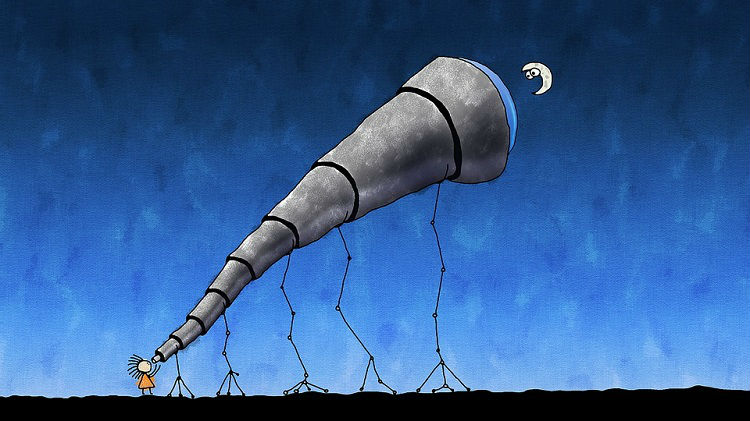 The earliest astronomical observations are older than the earliest written records. Image: Pixabay.
The earliest astronomical observations are older than the earliest written records. Image: Pixabay.
It was Nicolaus Copernicus in the 16th century who proposed that the Sun, rather than the Earth, was the center of the Universe. Others had done so before, but Copernicus was the first to formulate a cohesive model of the Solar System based on scientific observation.
Later, in the 19th century, astronomers discovered that the Sun wasn't the center at all. Instead, our Sun was just one average star of many inhabiting the Milky Way Galaxy, which was, at the time, the only known galaxy in the entire Universe.
Finally, in the early 20th century, astronomers reached the consensus that the Milky Way Galaxy wasn't the only galaxy in the Universe. What were thought to have been distant gas clouds in the Milky Way were in fact determined to be other galaxies extremely far away.
Our galaxy turned out to be just one of many which inhabited a much larger cosmos than we had previously thought possible.
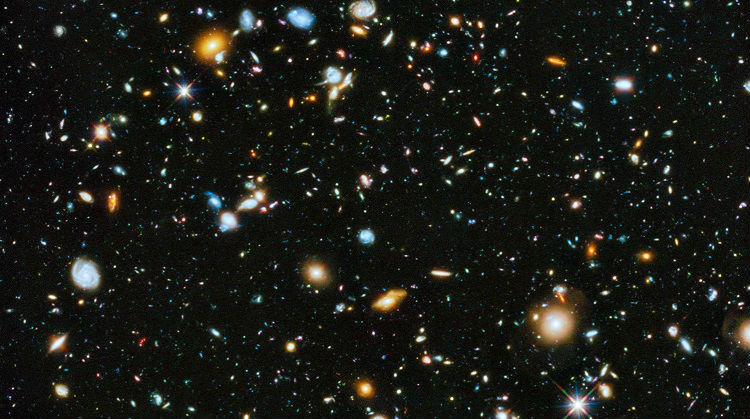 The Hubble Ultra-Deep Field — distant Galaxies from 13 billion years back in time. Image: NASA/ESA/H. Teplitz/M. Rafelski/A. Koekemoer/R. Windhorst/Z. Levay.
The Hubble Ultra-Deep Field — distant Galaxies from 13 billion years back in time. Image: NASA/ESA/H. Teplitz/M. Rafelski/A. Koekemoer/R. Windhorst/Z. Levay.
Today, we know that we reside on a small-ish planet revolving around an average-sized star in an outer arm of the Milky Way Galaxy, which is itself just an average-sized spiral galaxy within a 'supercluster' of 100,000 galaxies—and that's just the neighborhood we're from. In total, there are hundreds of billions of galaxies, each containing hundreds of billions of stars.
From this astronomical vantage point, Earth and Earthy things appear less significant. As our many spacecraft travel faster and further away from Earth, we look outwards to the cosmos more than ever before. We hope to unlock more of its secrets, to learn more through scientific inquiry, and to forge a deeper connection to the vast stellar ocean that surrounds us.
We're no longer just an Earth-bound species. After over a half-century of spaceflight, we've reach an evolutionary turning point. We're becoming a Space-bound species.
When looking at images of Earth from space, we can get a good sense of this global shift towards an astronomical perspective. Here are seven unique vantage points from which Earth—the birthplace of every human being that has ever lived—begins to look like just another object in a cluttered sky.
1. Earth from Orbit:
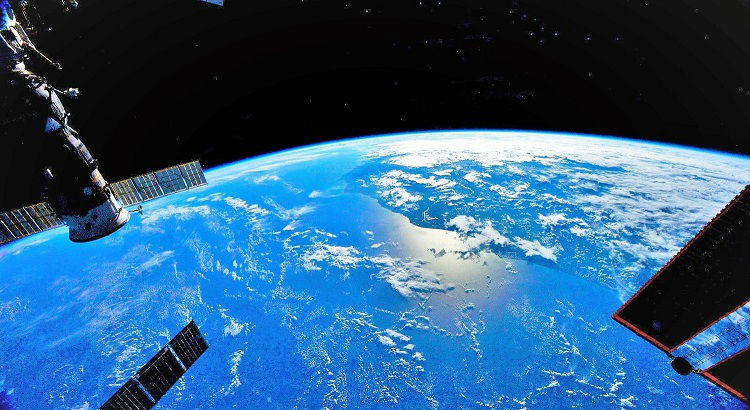 A view of Earth from 400 kilometers (250 miles) above the ground. Image: ESA/NASA/Samantha Cristoforetti.
A view of Earth from 400 kilometers (250 miles) above the ground. Image: ESA/NASA/Samantha Cristoforetti.
This photo of the Atlantic coast of South America was captured by Italian astronaut Samantha Cristoforetti while she was on board the International Space Station (ISS), that giant orbiting laboratory in the sky.
From a few hundred kilometers up, national borders melt away. A continent or an ocean may dominate the foreground, perhaps a large city or two is visible—but for the most part, Earth from orbit looks more like an interconnected circuit-board than a collection of quarreling states.
More than 500 astronauts and cosmonauts have ventured into space and looked upon our blue Earth from this perspective. From space, Earth's atmosphere appears thin and vulnerable; the ecological damage being generated by 7 billion humans is visible from hundreds of kilometers above the planet.
In order to get a real sense for the fragility of the planet we all inhabit, the best possible vantage point is in Low-Earth Orbit. And with companies like Blue Origin and Virgin Galactic looking to pioneer the sub-orbital space-tourism industry, more people may soon get the opportunity to catch a glimpse of Earth from this unique perspective.
2. Earth from Cis-Lunar Space:
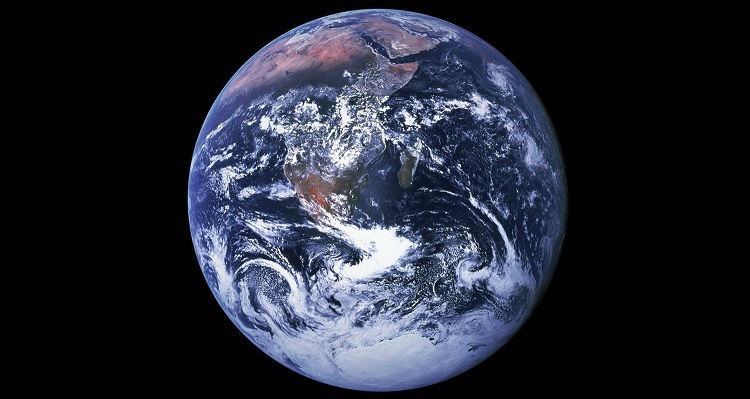 The entire Earth seen from 45,000 kilometers (28,000 miles) away. Image: NASA (1972).
The entire Earth seen from 45,000 kilometers (28,000 miles) away. Image: NASA (1972).
*While American astronauts Gene Cernan, Ron Evans, and Jack Schmitt of Apollo 17 (the last manned mission to the Moon) were en-route back to Earth, they snapped this image through the window of their spacecraft (circa 1972).
Clearly visible in the photo is the entire continent of Africa, the ancestral birthplace of all modern humans. NASA claims that this image is among the most widely distributed images in all of human history.*
From some tens of thousands of kilometers away, even the concept of segregated continents seems arbitrary. Earth is the common inheritance of all mankind, and the idea that humans living on the North American continent have access to more resources and opportunities than humans living on the African continent (for example) just seems nonsensical.
Only 24 humans have seen Earth from this grand perspective, all of them Apollo astronauts that flew to the Moon between 1968 – 1972. Never before or since have any human beings seen the whole sphere of Earth at one time.
3. Earth from The Moon:
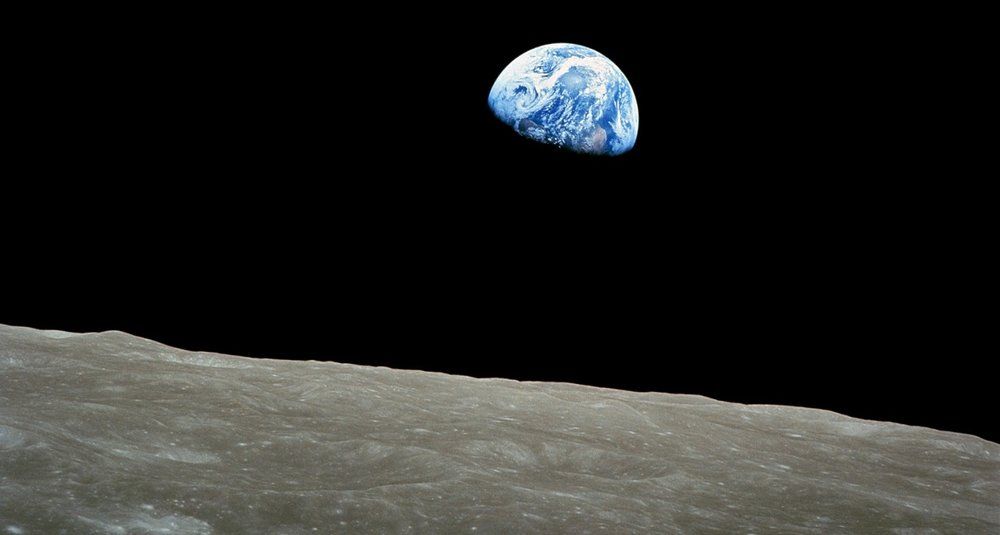
*In December of 1968, Apollo 8 astronauts Frank Borman, Jim Lovell, and Bill Anders became the first humans to travel beyond low-Earth orbit, the first to see Earth as a whole planet, and the first to fly to the Moon. As their spacecraft came around the dark side of the Moon, they also became the first humans to witness an Earthrise — the illusion of the Earth ‘rising’ into the sky (like a sunrise here on Earth).
This image also represents the furthest place to which human beings have ever traveled away from home. But even at this furthest point, our big blue ball is still clearly visible in the sky.*
From the surface of the Moon, Earth resembles a blue orb hovering in the sky—one side illuminated by the Sun, the other shrouded in the darkness of night.
An even more exclusive club to those that have flown to the Moon is those who have left boot-prints in Lunar soil. Only 12 astronauts walked on the Moon between 1969 – 1972. And of those 12, only seven are alive today—the youngest of whom, Apollo 16's Charles Duke, is now 80 years old.
It's estimated that the total number of human beings who have ever lived, beginning from around the year 50,000 BC, is around 107 billion. Of that total, 7 billion humans are living today (meaning there are approximately 100 billion dead people in human history).
Of those 107 billion, only 12 people ever stepped foot on an object other than Earth. Only these 12 have had their feet planted on the surface of another world and looked up at the planet Earth suspended in the sky.
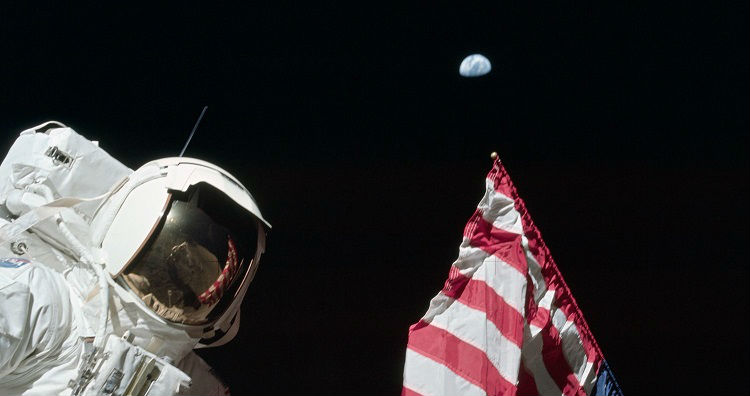 America. Image: NASA/Eugene Cernan (1972).
America. Image: NASA/Eugene Cernan (1972).
The Moon is tidally locked to Earth; one side of the Moon always faces us, while the other side always faces away. This means that, wherever you stand on the Moon, Earth never moves in the sky—it remains fixed in place (unless, of course, you move across the surface of the Moon).
And there it will hover, the entirety of our civilization, the homeworld of every human dead or alive (up to this point), a blue orb 400,000 kilometers away. Future travelers to (and inhabitants of) the Moon will have this permanent fixture hanging above their heads at all times... or, if they choose to escape to the far side of the Moon, not at all.
4. Earth from Mars:
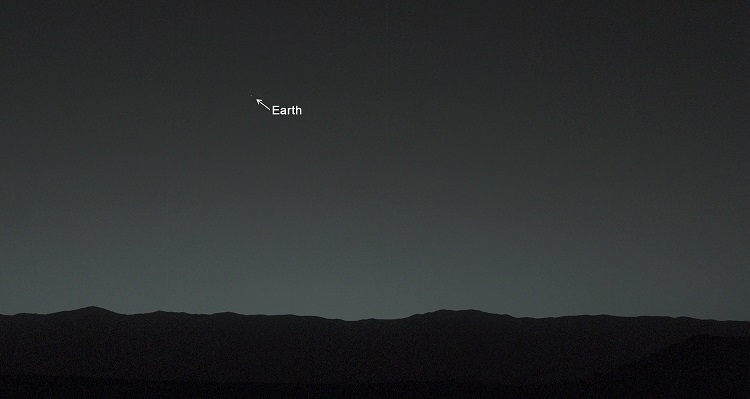 An image of Earth in the Martian sky, 160 million kilometers (99 million miles) away. Image: NASA/JPL-Caltech/MSSS/TAMU (2014).
An image of Earth in the Martian sky, 160 million kilometers (99 million miles) away. Image: NASA/JPL-Caltech/MSSS/TAMU (2014).
On January 31st, 2014, the Mars rover Curiosity captured this picture of Earth — which looks like a star in the sky — shortly after sunset on Mars. Or, put another way: this photo of Earth was taken on another planet, by a 900-kilogram robot on wheels, operated by remote control from 160 million kilometers away. Now there’s some perspective.
From here, Earth is indistinguishable from the stars. Its color and grandeur fade away, and the red planet seems far more real than the distant homeworld. Only robots have ventured this far, thus far. But one day, to humans living on the Martian surface, the twinkle of Earth in the sky will appear as common as the twinkle of Mars is to us here on Earth—it mostly shines unnoticed, blending in seamlessly with the stars in the night sky.
Because Mars takes nearly twice as long to orbit the Sun as Earth does, there are times in the Martian year when Earth is on the opposite side of the sun and isn't visible in the Martian sky at all. While at their furthest point of separation, communications between Earth and Mars can be delayed by 24 minutes each way, as that's how long it takes for a signal to travel the hundreds of millions of kilometers between the two planets.
By comparison, Earth-Moon communications are only delayed by 1 – 2 seconds. When humans first step foot on Mars, they'll be the most isolated group of people that has ever been alive (by sheer travel time between the next-closest group of people).
5. Earth (and Moon) from Deep Space:
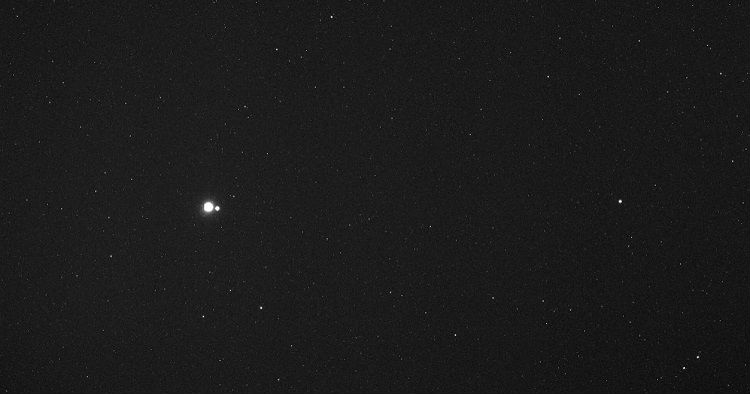
While NASA's MESSENGER spacecraft was on its way to the planet Mercury in 2010, it took the time to turn around and snap this photo of the Earth-Moon system. MESSENGER launched in 2004 and became the first spacecraft ever to orbit Mercury in 2011 (previous craft had simply flown by).
From this vantage point, we're really out there. This spacecraft is traveling to another world, a long way from Earth, and it will never return to the planet that it was originally constructed on. While traversing the vast distances of the cosmos, the affairs of the planet being left behind seem trivial and inconsequential.
Like a ship at sea, this starship roams the cosmic ocean in search of new lands. There are no planets in the foreground, and the Sun takes precedence as the largest object in the sky. When we sending humans to other planets for the first time, the depths of interplanetary space will be the loneliest frontier that human beings have ever encountered.
6. Earth from Saturn:
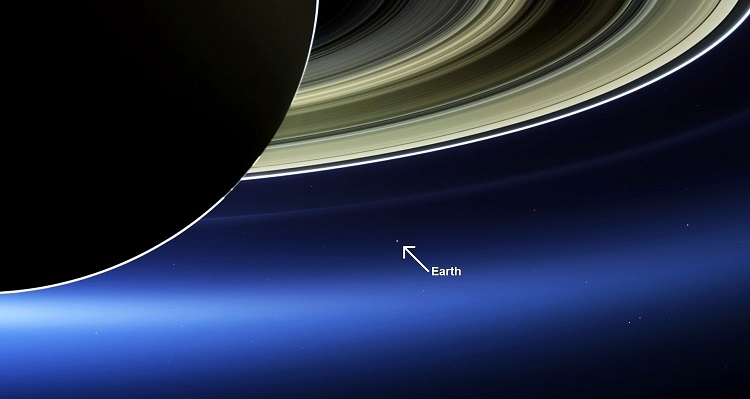 Earth spotted from orbit around Saturn, 1.44 billion kilometers (900 million miles) away. Image: NASA/JPL-Caltech/SSI (2013).
Earth spotted from orbit around Saturn, 1.44 billion kilometers (900 million miles) away. Image: NASA/JPL-Caltech/SSI (2013).
*Captured in 2013 by NASA’s Cassini spacecraft, which has been operating in orbit around Saturn since 2004 (and which launched all the way back in 1997), light from the Earth took nearly 90 minutes to reach the spacecraft’s camera lens.
From this otherworldly perspective, Earth looks as thought it could masquerade as one of Saturn’s moons, many of which are visible in the full-sized image released by NASA.*
Out here, things really are alien. This image from the Saturnian system, with its methane-covered moon Titan and its geyser-spewing moon Enceladus, makes Earth appear as just another one of the many moons orbiting Saturn.
Perhaps one day, human beings will be able to scrape by inhabiting one of Saturn's strange moons. People born in the outer solar system will look towards Earth in wonder, contemplating how their ancestors could ever have originated from such a tiny little speck in the distant sky.
Just as with Mars, there will be times when Earth won't be visible from Saturn. And since its moons are all tidally locked to the giant planet, Saturn would appear to hang as a permanent fixture in the sky of Titan or Enceladus—much like Earth does in the Lunar sky, but more spectacular. From this alien perspective, Saturn reigns supreme—Earth is 90 minutes away via light-speed, and barely visible in the star-filled sky.
7. Earth from Beyond:
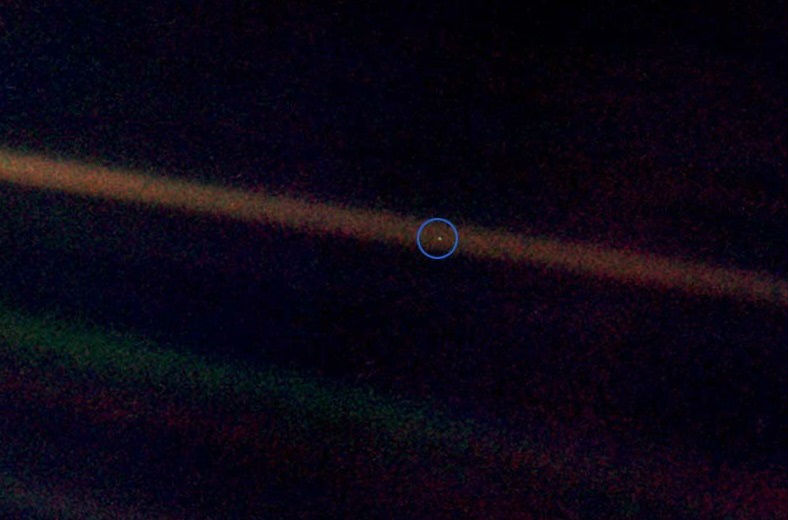
*In 1977, NASA launched its Voyager 1 probe to study the outer planets of the solar system, particularly Jupiter, Saturn, and Saturn’s largest moon: Titan. In 1990, while Voyager 1 was outside the orbits of both Neptune and Pluto (the furthest planets from the sun, at the time), NASA had the probe turn around and snap this ominous photo of Earth. Light from Earth took six hours to reach the spacecraft’s camera lens and show up as this pale blue dot.
Today, in 2016, Voyager 1 is still going — it’s been traveling for 38 years (and still sending little bits of data back), flown about 20 billion kilometers through space, and is now the furthest man-made object from Earth. Far enough that, if this same probe tried to take a picture of Earth today, our fragile world probably wouldn’t even show up in a single pixel.*
From this perspective, we're about to leave the Solar System behind and become interstellar. Earth is a pixel in the rear-view mirror. Everything that has ever happened in the history of humanity looms behind, fading away as though it were some distant memory.
Ever since human beings first began making maps, our vantage point has been expanding. It began with a regional map of an area, boundaries marked by rivers or mountains. Then it became whole continents, subdued only by the vastness of the oceans. Finally, in the 20th century, the entire globe had been mapped. From there, we looked to the stars.
As we started capturing pictures of the cosmos, Earth shrunk further still. From Voyager 1out on the edge of the Solar System, nothing is nearby—no safe harbor, nowhere to stop for rest—only the vastness of interstellar space that lay ahead.
One day, as long as civilization doesn't completely collapse, some human being may experience a moment like this. A moment where the entire history of humanity—all 100+ billion people, forged on that pale blue dot barely visible from here—is left behind. Interstellar space and the whole cosmos lay ahead.
These early images of our world from space are the antiques of humanity's future. They'll one day appear in a history book, arranged inside of the chapter which follows the Apollo missions to the Moon, embedded under a heading that reads something like "When Human Beings First Began Exploring Other Worlds."
This is the historical epoch in which we all presently reside, whether we're aware of it or not. From the astronomical perspective, Earth is just our starting point—and the whole of the Cosmos is our collective future.



